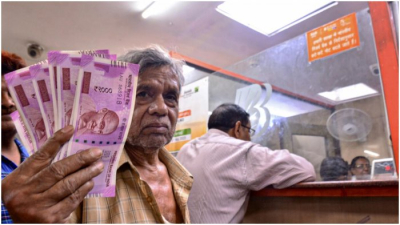
The Reserve Bank of India recently announced its decision to withdraw the Rs. 2000 notes from circulation. The public has been advised to deposit and/or exchange these banknotes on or before September 30. These notes were introduced in November 2016 as part of demonetisation. Let us know more about demonetisation.
Demonetisation
On November 8, 2016, Prime Minister Narendra Modi announced the demonetisation of Rs. 500 and Rs. 1000. The move was made to prevent the accumulation and circulation of black money in the country.
The sudden decision to ban these notes caused anxiety and panic among the public. Banks and ATMS witnessed huge queues with people waiting for several hours to exchange / get their cash.
The case of Rs. 2000 notes
The Rs. 2000 notes were introduced in 2016 to meet the currency requirement after Rs. 500 and Rs. 1000 notes were withdrawn. The printing of Rs. 2000 notes was stopped in 2018-2019 once there were enough notes of other denominations. Recently, the RBI announced that in pursuance of the Clean Note Policy, the Rs. 2000 notes will be withdrawn from circulation.
There is a difference between demonetisation and withdrawal of currency. While demonetisation is the process of removing a monetary unit's legally accepted status, withdrawing a currency from circulation does not affect their legal tender status. This means that while Rs. 2000 will be valid for use in business and exchange transactions, the notes will be set aside when they arrive at banks to be deposited in the RBI and will no longer be distributed to the general public.
Clean Note Policy
The Clean Note Policy, first announced in 1999, seeks to provide citizens high-quality currency notes and coins with better security features, while removing worn-out notes from circulation. For instance, on Rs. 2000 notes, the security features include readable and windowed security thread alternately visible on the obverse with the inscriptions 'Bharat (in Hindi), '2000', and 'RBI'.
In 2018, a new Clean Note Policy was announced to make digital payments more secure.
In 2005, the RBI withdrew all banknotes issued before 2005 from circulation, as they had fewer security features than banknotes printed after 2005. The notes issued before 2005 do not have on them the year of printing on the reverse side.
In 2002, the RBI inaugurated Currency Verification and Processing (CVPS) Machines for checking numerical accuracy and genuineness of the currency notes.
The CVPS system is capable of processing 50,000 – 60,000 soiled notes per hour. The system, along with the Shredding and Briquetting System for destruction of soiled notes, helps faster withdrawal of soiled and mutilated notes from the market. These machines are installed at both regional and zonal RBI offices.
Picture Credit : Google




